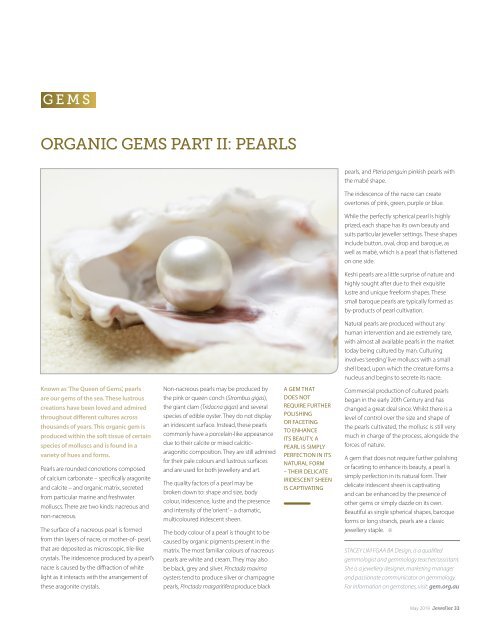Jeweller - May 2019
Create successful ePaper yourself
Turn your PDF publications into a flip-book with our unique Google optimized e-Paper software.
GEMS<br />
ORGANIC GEMS PART II: PEARLS<br />
pearls, and Pteria penguin pinkish pearls with<br />
the mabé shape.<br />
The iridescence of the nacre can create<br />
overtones of pink, green, purple or blue.<br />
While the perfectly spherical pearl is highly<br />
prized, each shape has its own beauty and<br />
suits particular jeweller settings. These shapes<br />
include button, oval, drop and baroque, as<br />
well as mabé, which is a pearl that is flattened<br />
on one side.<br />
Keshi pearls are a little surprise of nature and<br />
highly sought after due to their exquisite<br />
lustre and unique freeform shapes. These<br />
small baroque pearls are typically formed as<br />
by-products of pearl cultivation.<br />
Natural pearls are produced without any<br />
human intervention and are extremely rare,<br />
with almost all available pearls in the market<br />
today being cultured by man. Culturing<br />
involves ‘seeding’ live molluscs with a small<br />
shell bead, upon which the creature forms a<br />
nucleus and begins to secrete its nacre.<br />
Known as ‘The Queen of Gems’, pearls<br />
are our gems of the sea. These lustrous<br />
creations have been loved and admired<br />
throughout different cultures across<br />
thousands of years. This organic gem is<br />
produced within the soft tissue of certain<br />
species of molluscs and is found in a<br />
variety of hues and forms.<br />
Pearls are rounded concretions composed<br />
of calcium carbonate – specifically aragonite<br />
and calcite – and organic matrix, secreted<br />
from particular marine and freshwater<br />
molluscs. There are two kinds: nacreous and<br />
non-nacreous.<br />
The surface of a nacreous pearl is formed<br />
from thin layers of nacre, or mother-of- pearl,<br />
that are deposited as microscopic, tile-like<br />
crystals. The iridescence produced by a pearl’s<br />
nacre is caused by the diffraction of white<br />
light as it interacts with the arrangement of<br />
these aragonite crystals.<br />
Non-nacreous pearls may be produced by<br />
the pink or queen conch (Strombus gigas),<br />
the giant clam (Tridacna gigas) and several<br />
species of edible oyster. They do not display<br />
an iridescent surface. Instead, these pearls<br />
commonly have a porcelain-like appearance<br />
due to their calcite or mixed calciticaragonitic<br />
composition. They are still admired<br />
for their pale colours and lustrous surfaces<br />
and are used for both jewellery and art.<br />
The quality factors of a pearl may be<br />
broken down to: shape and size, body<br />
colour, iridescence, lustre and the presence<br />
and intensity of the ‘orient’ – a dramatic,<br />
multicoloured iridescent sheen.<br />
The body colour of a pearl is thought to be<br />
caused by organic pigments present in the<br />
matrix. The most familiar colours of nacreous<br />
pearls are white and cream. They may also<br />
be black, grey and silver. Pinctada maxima<br />
oysters tend to produce silver or champagne<br />
pearls, Pinctada margaritifera produce black<br />
A GEM THAT<br />
DOES NOT<br />
REQUIRE FURTHER<br />
POLISHING<br />
OR FACETING<br />
TO ENHANCE<br />
ITS BEAUTY, A<br />
PEARL IS SIMPLY<br />
PERFECTION IN ITS<br />
NATURAL FORM<br />
– THEIR DELICATE<br />
IRIDESCENT SHEEN<br />
IS CAPTIVATING<br />
Commercial production of cultured pearls<br />
began in the early 20th Century and has<br />
changed a great deal since. Whilst there is a<br />
level of control over the size and shape of<br />
the pearls cultivated, the mollusc is still very<br />
much in charge of the process, alongside the<br />
forces of nature.<br />
A gem that does not require further polishing<br />
or faceting to enhance its beauty, a pearl is<br />
simply perfection in its natural form. Their<br />
delicate iridescent sheen is captivating<br />
and can be enhanced by the presence of<br />
other gems or simply dazzle on its own.<br />
Beautiful as single spherical shapes, baroque<br />
forms or long strands, pearls are a classic<br />
jewellery staple. i<br />
STACEY LIM FGAA BA Design, is a qualified<br />
gemmologist and gemmology teacher/assistant.<br />
She is a jewellery designer, marketing manager<br />
and passionate communicator on gemmology.<br />
For information on gemstones, visit: gem.org.au<br />
<strong>May</strong> <strong>2019</strong> <strong>Jeweller</strong> 33


















